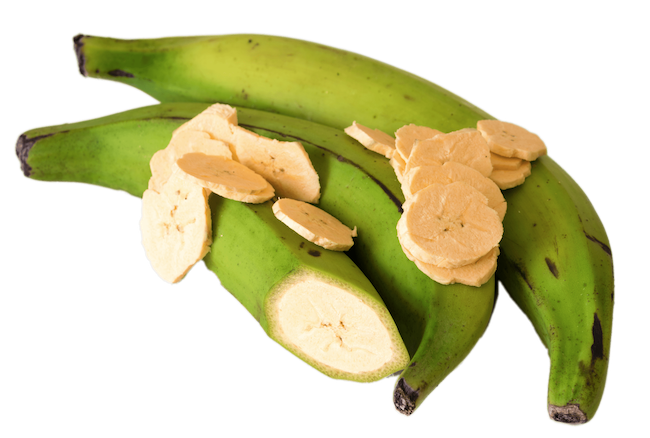Cheap Eats:
Mtori
(East African Plantain Stew)
I'd always thought that bananas grew on trees. They don't. They grow on tall herbs. I made this astonishing discovery more than a decade ago, while on a tour of a banana plantation in Western Australia. The banana plant is mostly water, held together with a bit of greenery. It grows rapidly, produces one enormous purple flower, which, when pollinated produces one very large bunch of bananas, then the plant dies. A new plant starts up from its roots almost immediately.
In addition to being the world's biggest herb, the banana as we know it is a hybrid—a cross of two wild species that are still eaten in Africa today. In the wild, bananas are full of seeds and not terribly appetizing. That's why it seems likely that the banana was cultivated (rather than simply found wild) relatively early. There are records that it was being consumed in the Indus valley more than 4,000 years ago, but those records do not give any hint as to whether cultivation had set in at that point.

Though we have documentation of the existence and consumption of bananas from an early date, most of it was in reports made by people who simply saw the fruit—such as Alexander the Great and his soldiers, when they invaded India—or who possibly even sampled it while traveling. However, because it is highly perishable and difficult to transport, the banana made its way around the world at a snail's pace. Pliny described the fruit, but never saw it, and bananas never appear to have reached Greece or Rome.
Arabs may have cultivated bananas in North Africa, but the primary evidence of this is that the Koran identifies the fruit consumed by Adam and Eve in the Garden of Eden as being a banana. (And banana leaves, which run up to twelve feet in length, would be far more effective than fig leaves for covering yourself up.) It is likely, however, that the banana came to Africa before the Arabs brought it in, carried by Indonesian invaders who overran Madagascar early in the Christian era.
While the first bananas were planted in the Americas in 1516, when Friar Tomás de Berlanga got them started on the island of Hispaniola, they were not widely or consistently available in North America or Europe until after World War I. The reason that is particularly surprising is that, today, it is the most popular fruit in the U.S., with the average American consuming about 25 pounds a year. But that is not to say that the banana wasn't growing in popularity even before it was widely available.
The banana (in its approximately 400 variations, including the plantain) is one of the only staple foods of the world that is not a root or a grain. It is grown in virtually all tropical countries, but is exported chiefly by Colombia, Ecuador, Panama, Costa Rica, Honduras, and Guatemala—the so called "Banana Republics." (In fact, when I was in Ecuador, I learned that most of Quito's taxi cabs were purchased from Russia in exchange for a vastly large quantity of bananas, at a time when Russia needed food more than cars.) The only European country that grows bananas, oddly enough, is Iceland, where they are planted in soil heated by geysers.
Unlike the sweet bananas we consume as fruit, the plantain is generally treated as a vegetable. It is starchier, less sweet, and needs to be cooked. It can often be found prepared as fritters, battered and deep fried. I like to just slice them and sauté them in a little peanut oil, until golden and just getting brown at the edges, then sprinkle them with salt. Plantains appear in various tropical cuisines as snacks or side dishes, fried, mashed, or baked. In some places, they take the place of the potato.
This beef and plantain stew comes from East Africa. It is a delicious, substantial, filling dish. Though it sounds exotic, it actually borders on being comfort food. If you don't tell people that there are plantains in it, they'll probably be hard pressed to determine what it is that gives this dish that certain je ne sais quoi that makes it more fun than just another bowl of meat and potatoes.
Mtori
(Beef and Plantain Stew)
3 pounds beef short ribs
water
2 teaspoons salt
3 ripe plantains (about 1½ pounds), peeled and sliced into rounds ¼ inch thick
3 medium-sized new (red skinned) potatoes
2 medium onions, peeled and coarsely chopped
1 Tbs. butter
Peel and quarter the potatoes, then put them in a bowl of cold water to prevent discoloration.
Put the short ribs, 1 quart cold water, and salt in a 3- to 4-quart stew pot and bring to a boil over high heat. Skim the foam and scum as they rise to the surface. Reduce the heat to low and simmer, partially covered, for 1‑½ hours.
Add the plantains, drained potatoes, and onions, and continue simmering for another 30 minutes, or until the meat is tender and the potatoes can be mashed easily with a fork.
Remove the short ribs from the pot. Remove the meat from the bones and cut away the fat and gristle, and discard. Cut the meat into bite-size pieces.
Purée the soup and vegetables in a food processor or blender. (You will probably need to do this in batches, and you may need to add a little water, if the purée gets too thick.) Return the purée to the pot, add the meat, and stir in the butter. Heat through. Taste for seasoning. Enjoy.
Serves 4‑6.
Note:
Short ribs are pretty distinctive, so you wouldn't want to get rid of them completely, but if you're worried about fat, you could substitute a bit of chuck pot roast for part of the meat—say, one pound of chuck to 2 pounds of short ribs. It makes this a little less rich, but doesn't sacrifice taste.

